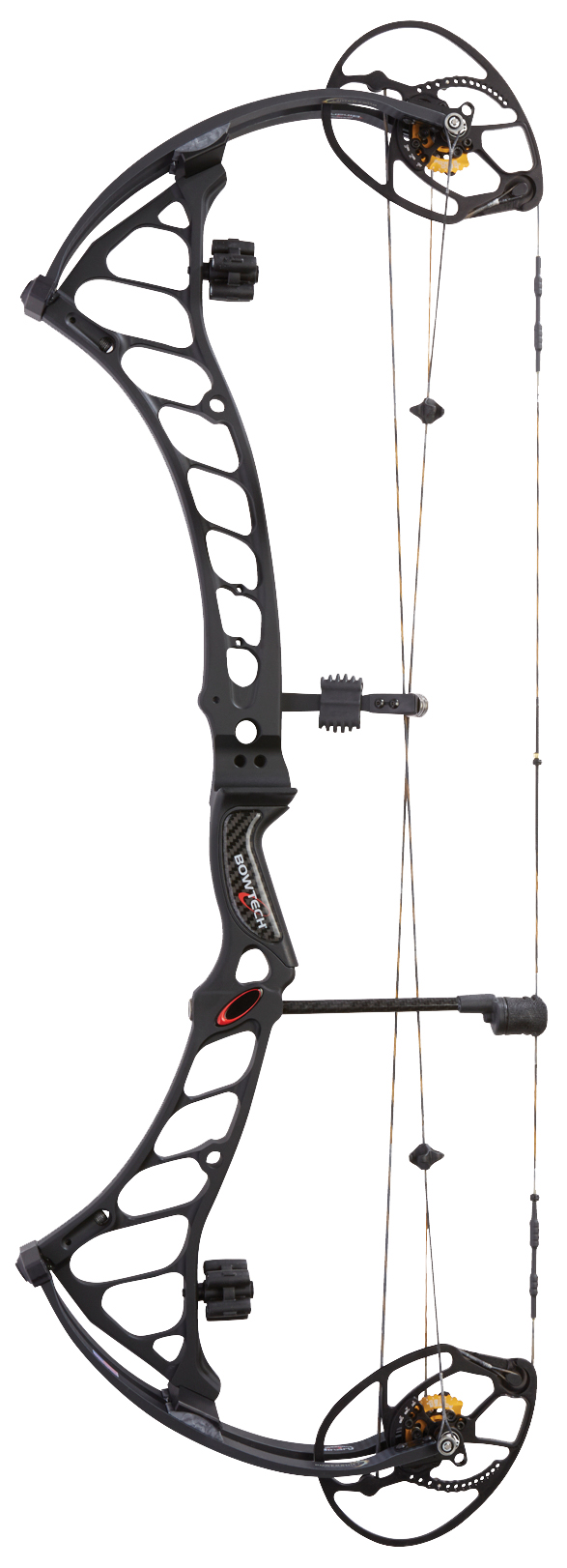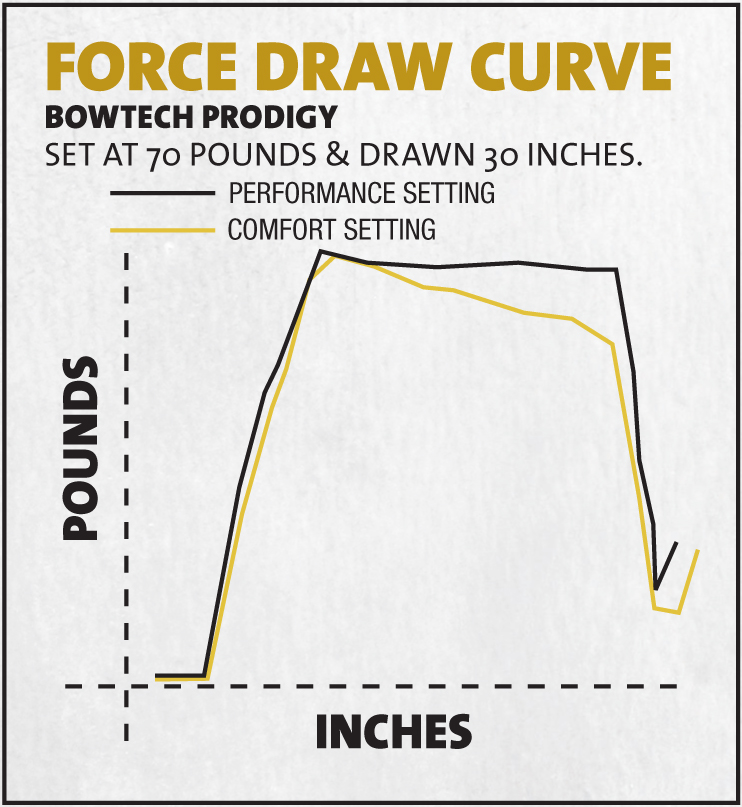Bowtech is among a handful of manufacturers whose bows are distinguishable at a glance, and the Prodigy certainly illustrates the point. This is not just a cosmetic quality. It represents, instead, a commitment to an overall approach to bow design that is reflected in the shape and relative proportions of the riser, limbs and cams, as well as any technologies intended to reduce torque or noise.
The Prodigy features the characteristically proportionately long riser and short, way-past-parallel limbs with Bowtech’s unique limb-pocket configuration, and the over-sized OverDrive Binary Cam system found on most of Bowtech’s recent and current lineup. The FLX-Guard cable stop and the Revolver limb dampeners are common to many other Bowtech bows as well.
What’s new, not just for Bowtech but for the entire industry, is the technology that enables the shooter to easily customize the Prodigy to offer maximum Performance (read: speed), maximum Comfort (read: smooth and easy to draw) or the Classic setting (read: somewhere between the two).
The settings are chang ed by removing one screw and loosening two others on the PowerDisc associated with each cam. The PowerDisc is rotated to one of three marked settings and the screws are retightened. Bowtech recommends using blue removable Loctite when making these changes. Draw length is modular and is adjustable between 25 and 30 ½ inches in half-inch increments, though the bow may need to be pressed on an approved press (Bowtech recommends a limb tip press) to execute changes in draw length, depending on which settings you’re using. Draw stops should then be moved to a corresponding position. As with the PowerDisc, Bowtech recommends using removable Loctite to secure draw-length modules.
ed by removing one screw and loosening two others on the PowerDisc associated with each cam. The PowerDisc is rotated to one of three marked settings and the screws are retightened. Bowtech recommends using blue removable Loctite when making these changes. Draw length is modular and is adjustable between 25 and 30 ½ inches in half-inch increments, though the bow may need to be pressed on an approved press (Bowtech recommends a limb tip press) to execute changes in draw length, depending on which settings you’re using. Draw stops should then be moved to a corresponding position. As with the PowerDisc, Bowtech recommends using removable Loctite to secure draw-length modules.
The test model was finished in BlackOps, against which the gold PowerDiscs and red logos really popped out. Fit and finish on the test model was flawless.
Shooting the Bow
The grip is often the first thing I notice on picking up a new bow. Bowtech has modified the Prodigy’s grip slightly over previous models. The old grips were good; the new one is better. It’s a little slimmer, somewhat more rounded instead of squared off and is generally more comfortable.
The Prodigy comes out of the box at 29 inches, so step one was to extend it to the IBO standard 30 inches for testing. The test bow also drew the scales to about 72 pounds, so I backed it down to 70. The limb bolts were not overly tight and turned smoothly. The test model was positioned at the Comfort setting, and I switched to the Performance setting for initial tests. The switch is not difficult and takes only a few minutes, but I’d recommend doing it in a clean, well-lit area and not in the field, where it would be easy to drop or lose small parts. Also, switching settings can affect draw weight or length. The changes are slight, but enough to change impact point and require sighting-in.
Bowtech’s OverDrive Cam System is justly noted for being easy to tune. Bowtech recommends finding centershot by measuring from the riser to the arrow at the face and at the back of the riser. When the two distances are equal, that is centershot. I squared the arrow on the vertical and was getting excellent arrow flight without further adjustment.
As the draw-force curve illustrates, the draw cycle on the Performance setting is fairly steep, building quickly up to peak. It levels off then and drops rapidly into the valley, with a solid back wall thanks to the string stops. At full draw I found it to be very steady. The speed is evident at the shot, but there is little if any discernible vibration, and the Prodigy is very quiet, especially with a stabilizer in place.
Since the Prodigy offers multiple settings, I thought it appropriate to deviate slightly from our usual testing procedure on the grounds that the Prodigy is not a usual bow. I switched back to the Comfort setting and did some additional testing. You can see from the draw-force curve that the Comfort setting does vary from the Performance setting. The initial climb to peak weight is similar, but instead of leveling off after this the draw weight slopes downward steadily, which means the shooter is holding at peak weight for less time during the draw cycle. Despite that, the drop-off into the valley is still somewhat sharp. Though I did not test speeds at all the possible combinations of draw weight, arrow weight and settings, I did shoot a 385-grain arrow at 70 pounds draw weight on the Comfort setting and achieved a speed of 302 fps, about 14 fps slower than when set at the Performance setting.
Subjectively I found that the difference between the settings, while significant, was not as dramatic as the draw-force chart might suggest. The biggest difference I noticed was in the valley. Though I didn’t find the cams “grabby” at the Performance setting, the valley was noticeably wider on the other settings. The overall difference between either the Performance setting or the Comfort setting and the in-between Classic setting is subtle.
The market will decide if there are a lot of bowhunters interested in the versatility this bow offers, but versatility in settings aside, the Prodigy is an excellent bow and arguably Bowtech’s best to date.
Bowtech Prodigy Specs
Letoff:……………………… 80%
Brace Height:………………7 inches
Weight:…………………….. 4.2 pounds (approximate)
Axle-To-Axle Length:…….. 32 inches
Speed:……………………… 343 fps
Draw Lengths:…………….. 25 to 30.5 inches, modular in half-inch increments, no press required.
Draw Weights:…..………… 50, 60, and 70 pound peak, adjustable down 10 pounds from peak.
Options:…………………… Kryptek Highlander, BlackOps, Mossy Oak BreakUp Country, Realtree Xtra Green.
Suggested Retail:………… $1,099
Objective Tests (30 Inches Draw)
Peak Hold*:…………………70 pounds
Weight, Full Draw*:………15.0 pounds
*Rounded to nearest half-pound
At 70-Pound Draw Weight
| Arrow Weight | Speed @ Launch | Speed @ 20 Yards | K.E. @ Launch | K.E. @ 20 Yards |
| 385 grains | 309 fps | 297 fps | 81.5 ft. lbs. |
75.5 ft. lbs. |
| 500 grains | 280 fps | 272 fps | 87.0 ft. lbs. | 82.0 ft. lbs. |
At 60-Pound Draw Weight
| Arrow Weight | Speed @ Launch | Speed @ 20 Yards | K.E. @ Launch | K.E. @ 20 Yards | Sound Level |
| 385 grains | 296 fps | 289 fps | 75.0 ft. lbs. | 71.5 ft. lbs. | 59.1 dBA |
| 500 grains | 263 fps | 259 fps | 77.0 ft. lbs. | 74.5 ft. lbs. | 47.5 dBA |







